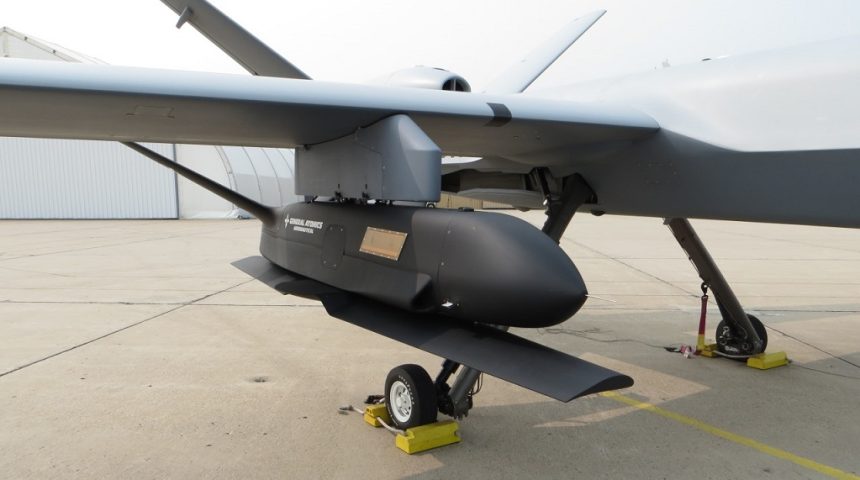The Drone, Called Sparrowhawk, Is A Demonstrator That Replicates Technologies Of The DARPA Gremlins Program.
General Atomics (GA-ASI) recently announced the first captive carry test of the Sparrowhawk Small Unmanned Aircraft Systems (sUAS). The test was carried out with the small drone carried under the right wing of an MQ-9 Reaper on Sept. 16 and 17, 2020.
The Sparrowhawk is a demonstrator for an air-launched and air-retrievable UAS that would fit the company’s aircraft. According to GA, the program is focused on Advanced Battle Management System’s attritableONE technologies and also iterates the DARPA Gremlins program that is demonstrating the launch and recovery from a C-130 of the X-61A Gremlins Air Vehicle (GAV).
#Sparrowhawk is a recoverable #SUAS that enables EW/SIGINT missions that are challenging from standoff platforms. With AttritableONE technology that is survivable & precise…a true game changer. https://t.co/BTGMK1zftt pic.twitter.com/Nr4Fz6LesA
— GA-ASI (@GenAtomics_ASI) September 25, 2020
“Sparrowhawk extends and multiplies MQ-9-based sensors, reduces manpower and increases ISR coverage. With attritableONE technology that is survivable and precise, Sparrowhawk is a true game changer”, said GA-ASI President David R. Alexander in the press release.
According to the company, the expendable sUAS will enable EW/SIGINT (Electronic warfare/SIGnals INTelligence) and ISR (Intelligence, Surveillance, Reconnaissance) missions in a contested environment, which may be challenging for the launcher aircraft that can maintain this way a standoff distance, identifying and reporting on mobile targets while flying also below adverse weather. The new system could allow also swarming tactics with reduced visual and acoustic signature.
The latter feature seem to be confirmed also by the use of a fielded meshONE datalink, that enabled collaborative autonomy capabilities among the platforms, and the Cooperation in Denied Environments (CODE) autonomy engine, that implemented cognitive Artificial Intelligence (AI) processing on the unmanned system.
The Sparrowhawk sUAS was controlled using GA-ASI’s Metis Software Defined Control Station hosted on a laptop computer instead of the standard Ground Control Station, reducing the system’s logistical footprint.
We never stop innovating. Meet #Sparrowhawk… our airborne launch and recovery demonstrator aircraft. Flight tests this week to demonstrate avionics systems and autonomy engine. Stay tuned! #SUAS pic.twitter.com/fM0FCYEhY5
— GA-ASI (@GenAtomics_ASI) September 15, 2020
Other than this, General Atomics did not provide technical specifications for the Sparrowhawk. From the photos released in the news statement and on Twitter, we can see that the drone has a single piece wing that is stowed parallel to the aircraft and rotates in position shortly after the launch. The aircraft also features a V tail and two small air intakes at the sides of the fuselage near the nose. It is not clear which type of engine will be used, as in the renderings the sUAS showed two fans at the sides of the fuselage near the tail, but they were not present in the photos of the test.
The company stated that the Sparrowhawk sUAS was developed also from the capabilities demonstrated when an MQ-1C Gray Eagle Extended Range carried two tube-launched Area-I Altius-600 Air Launched Effects (ALEs) during a Multi-Domain Operations demonstration in January. During a subsequent test in June, the ALEs were launched and controlled through the MQ-1C, after the target was identified and located by the Gray Eagle Communications Intelligence (COMINT), Electronic Intelligence (ELINT) and Synthetic Aperture Radar (SAR) payloads, and provided real-time full-motion video to simulated ground forces over a Tactical Scalable Mobile (TSM) network.
GA-ASI just completed a month-long demo event, showcasing a suite of long-range sensors, Air Launched Effects and Scalable Command and Control on the #GrayEagle Extended Range UAS. This was the third in a series of demonstrations for the #USArmy. #ISRhttps://t.co/LEHXwftCll pic.twitter.com/sUoAPbAuZh
— GA-ASI (@GenAtomics_ASI) June 29, 2020
. @CCDC_AVM led a demo for the forward air launch ALTIUS, 600. The demo is in line with the @USArmy pursuit of leap-ahead technological advances aimed at dominating its adversaries and reaching its Multi-Domain Operations goal. #ArmyFutures #adapt2winhttps://t.co/3N86p8csnV pic.twitter.com/enZB95Mr3O
— CCDC Aviation & Missile Center (@CCDC_AvMC) April 1, 2020
Another detail that we don’t know yet is how GA is planning to perform the airborne recovery of the Sparrowhawk. While not specified, the concept could be similar to DARPA’s Gremlin program, with the UAS recovered by a C-130 at the end of the mission and returned home to be prepared for the next mission.









